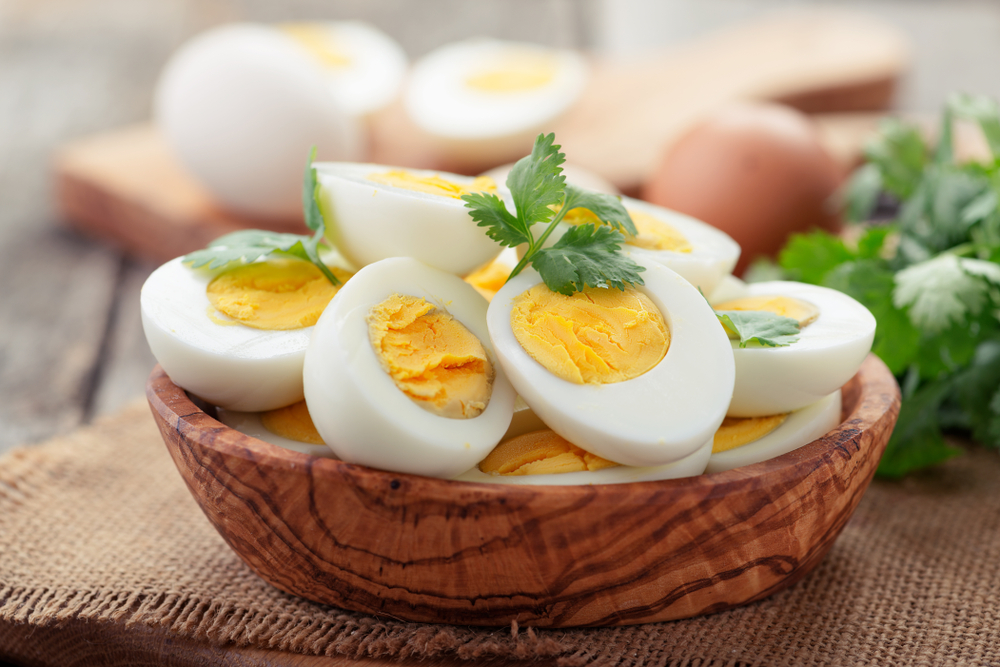Salad dressing is an essential component of any salad, and it can add flavor and texture to your greens. But what type of mixture is called salad dressing?
Salad dressing is a heterogeneous mixture that consists of two or more substances that are not chemically combined.
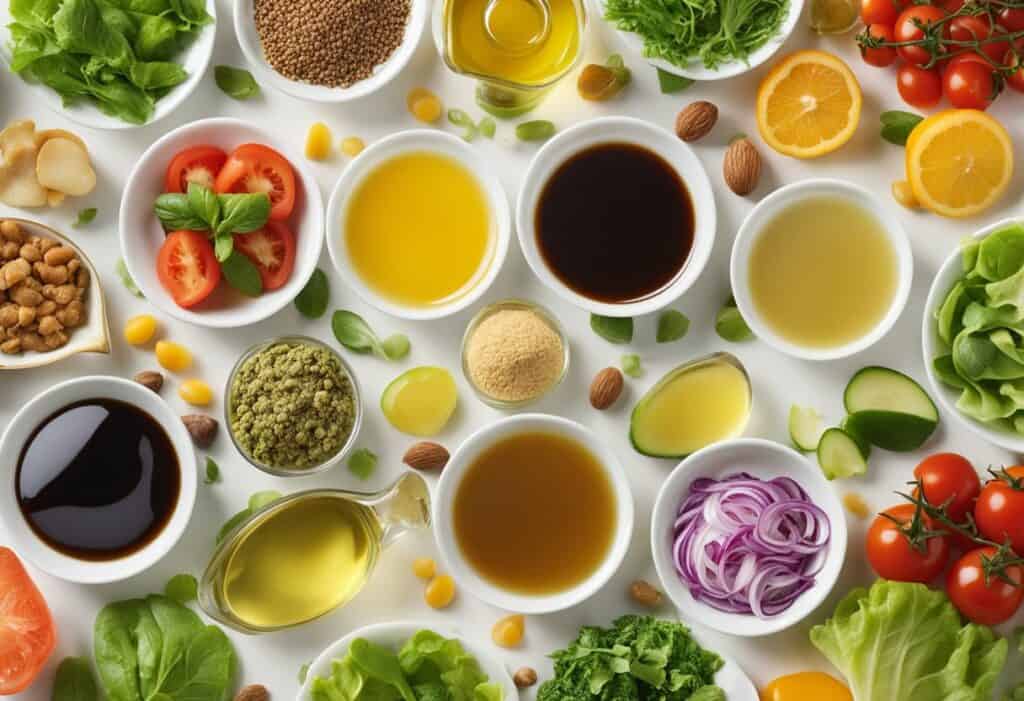
Understanding Salad Dressing is important because it can help you choose the best dressing for your salad.
There are several types of salad dressings, including vinaigrette, creamy, and boiled dressings. Each type of salad dressing has its unique flavor and texture, and it is important to choose the right one for your salad.
Key Takeaways
- Salad dressing is a heterogeneous mixture that consists of two or more substances that are not chemically combined.
- There are several types of salad dressings, including vinaigrette, creamy, and boiled dressings.
- Understanding Salad Dressing can help you choose the best dressing for your salad.
Understanding Salad Dressing
Salad dressing is a mixture of ingredients that is added to a salad to enhance its flavor. It is also commonly referred to as dressing or sauce.
Salad dressings can be made from a variety of ingredients, including oil, vinegar, herbs, spices, and other flavorings.
One of the most common types of salad dressing is oil and vinegar. This type of dressing is made by combining oil and vinegar in a ratio of three parts oil to one part vinegar. The oil and vinegar are whisked together until they are emulsified, creating a smooth and creamy texture.
Other types of oil-based dressings include Italian dressing, which is made with oil, vinegar, and a blend of herbs and spices, and Caesar dressing, which is made with oil, lemon juice, garlic, anchovies, and Parmesan cheese.
Emulsification is a key process in making salad dressing. It is the process of mixing two liquids that do not normally mix, such as oil and vinegar.
Emulsification creates a stable mixture that does not separate over time. To emulsify salad dressing, the ingredients are whisked together vigorously or blended in a food processor or blender.
When making salad dressing, it is important to consider the ratio of oil to vinegar. The ratio can vary depending on personal preference and the type of salad being served.
A general rule of thumb is to use a ratio of three parts oil to one part vinegar, but this can be adjusted to suit individual tastes.
In conclusion, salad dressing is a mixture of ingredients that is added to a salad to enhance its flavor. It can be made from a variety of ingredients, including oil, vinegar, herbs, and spices.
Emulsification is a key process in making salad dressing, and the ratio of oil to vinegar can be adjusted to suit individual tastes.
Types of Salad Dressing
Salad dressings come in a variety of types and flavors, and they can make all the difference when it comes to enjoying a salad. Below are some of the most popular types of salad dressing:
Vinaigrette Dressing
Vinaigrette is a classic dressing made from oil, vinegar, and seasonings. It is typically used on leafy green salads and can be customized with different types of vinegar, such as balsamic or red wine vinegar, to change the flavor profile.
Mayo-Based Dressing
Mayo-based dressings, such as ranch and blue cheese, are creamy and tangy. They are often used on salads with heartier ingredients like chicken or bacon.
French Dressing
French dressing is a tangy, tomato-based dressing that is often used on salads with a variety of vegetables. It has a slightly sweet taste and can be used as a marinade for meat.
Italian Dressing
Italian dressing is a classic dressing made from oil, vinegar, and Italian seasonings like oregano and basil. It is often used on pasta salads and can be used as a marinade for chicken.
Thousand Island Dressing
Thousand Island dressing is a creamy dressing made with mayonnaise, ketchup, and sweet pickle relish. It is often used on salads with ingredients like hard-boiled eggs and avocado.
Honey Mustard Dressing
Honey mustard dressing is a sweet and tangy dressing made with honey, mustard, and vinegar. It is often used on salads with ingredients like grilled chicken and bacon.
Green Goddess Dressing
Green goddess dressing is a creamy dressing made with herbs like parsley and chives. It is often used on salads with ingredients like shrimp and avocado.
Creamy Dressings
Creamy dressings like ranch and blue cheese are popular choices for salads with heartier ingredients. They are often made with mayonnaise or sour cream and can be customized with different seasonings.
In conclusion, salad dressings can make all the difference when it comes to enjoying a salad. With so many different types and flavors available, there is sure to be a dressing that suits your taste buds.
Key Ingredients in Salad Dressing
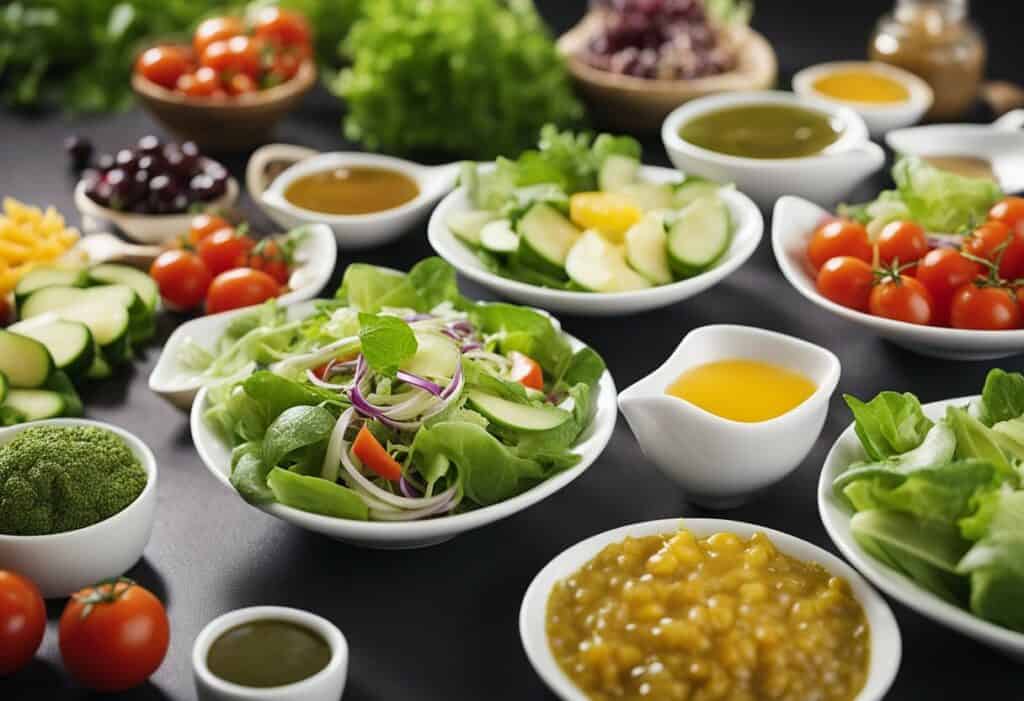
When it comes to salad dressings, there are a variety of ingredients that can be used to create a delicious and flavorful dressing. Some of the most common ingredients include:
- Vinegar: Vinegar is a key ingredient in many salad dressings and can add a tangy flavor to the dressing. Popular types of vinegar used in salad dressings include balsamic vinegar, apple cider vinegar, and red wine vinegar.
- Oil: Oil is another essential ingredient in salad dressings as it helps to emulsify the other ingredients. Popular oils used in salad dressings include olive oil, vegetable oil, and sesame oil.
- Herbs and Spices: Herbs and spices can add a lot of flavor to salad dressings. Popular herbs used in salad dressings include basil, thyme, and oregano, while popular spices include paprika and garlic.
- Cheese: Cheese can add a rich and creamy flavor to salad dressings. Popular cheeses used in salad dressings include parmesan cheese and blue cheese.
- Sugar and Honey: Adding a touch of sweetness to salad dressings can help to balance out the acidity. Popular sweeteners used in salad dressings include sugar and honey.
- Mustard: Mustard can add a tangy flavor to salad dressings and also helps to emulsify the other ingredients.
- Lemon and Lime: Lemon and lime juice can add a bright and fresh flavor to salad dressings.
- Mayonnaise: Mayonnaise can be used as a base for creamy salad dressings.
- Yogurt and Sour Cream: Yogurt and sour cream can also be used as a base for creamy salad dressings.
- Salt: Salt is an important ingredient in salad dressings as it helps to bring out the flavors of the other ingredients.
It’s important to note that the pH level of salad dressings can also be an important factor. The ideal pH level for salad dressings is between 3.8 and 4.2, which is slightly acidic. This helps to preserve the dressing and prevent bacterial growth.
Overall, there are many different ingredients that can be used to create a delicious salad dressing. By experimenting with different combinations of vinegar, oil, herbs, spices, and other ingredients, you can create a dressing that perfectly complements your favorite salad.
Salad Dressing in Cooking
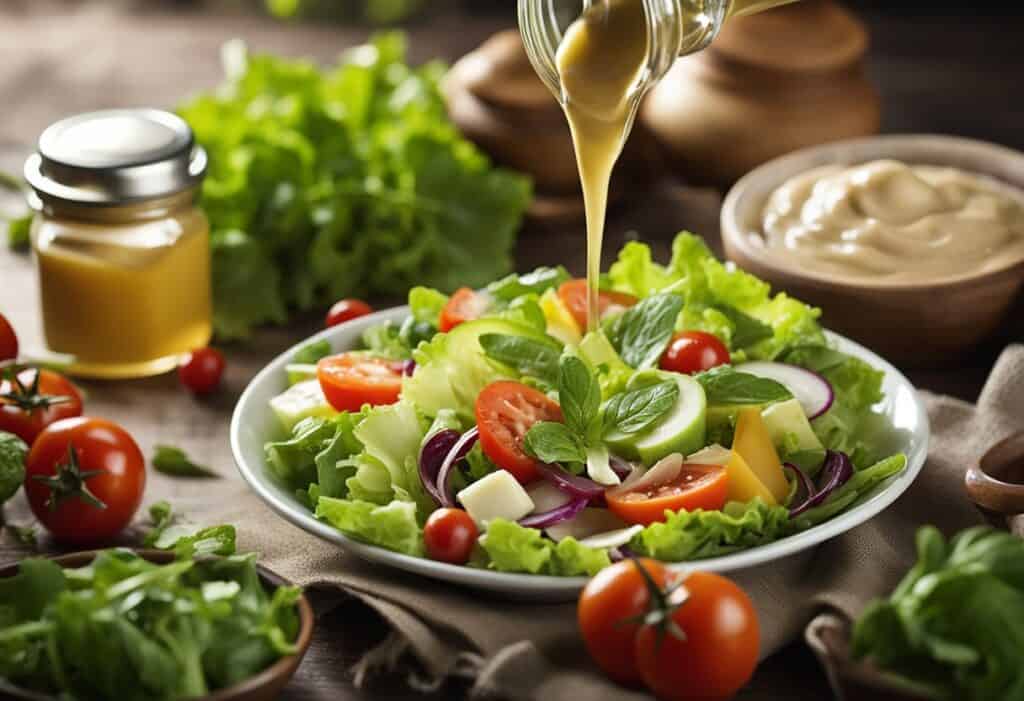
Salad dressing is a mixture of ingredients used to enhance the flavor of salads. It is a versatile ingredient that can be used as a marinade for meats, a dip for vegetables, or a sauce for pasta dishes.
Salad dressing can be drizzled over a bowl of greens or tossed with chicken wings for a delicious appetizer.
There are many different types of salad dressings, each with its own unique flavor profile. Some popular salad dressings include vinaigrettes, creamy dressings, and oil-based dressings. Vinaigrettes are made with oil and vinegar and are often used on salads with bold flavors.
Creamy dressings, on the other hand, are usually made with mayonnaise or sour cream and are perfect for milder salads. Oil-based dressings are made with a combination of oil and vinegar or lemon juice and are great for any type of salad.
Salad dressing can also be used as a marinade for meats. Simply coat the meat in the dressing and let it sit for a few hours in the refrigerator. The acidity in the dressing will help to tenderize the meat and infuse it with flavor.
In addition to salads, salad dressing can be used as a dip for vegetables or as a sauce for pasta dishes. It adds a burst of flavor to crudité and is a great way to make noodle or pasta salads more interesting. Salad dressing can also be used in potato salad for a tangy twist on a classic dish.
Overall, salad dressing is a versatile ingredient that can be used in a variety of ways to enhance the flavor of your dishes. With so many different types of salad dressings available, there is sure to be a flavor that you will love.
Making Your Own Salad Dressing
I love making my own salad dressing because it’s so easy and I can customize it to my liking. There are a few different methods you can use to make your own salad dressing, depending on the ingredients you’re using and your personal preference.
One method is to whisk the ingredients together in a bowl. This works well for simple dressings with just a few ingredients, like a vinaigrette. You can also use a jar with a tight-fitting lid and shake it vigorously to emulsify the ingredients.
If you’re making a larger batch of dressing, you might want to use a blender or food processor. This is especially useful if you’re using ingredients that need to be pureed, like herbs or garlic.
When making your own salad dressing, it’s important to taste as you go. Start with a small amount of each ingredient and add more as needed. You can always add more, but it’s hard to take away once it’s been added.
One of my favorite dressings to make is a homemade version of Hidden Valley ranch dressing. It’s creamy and flavorful, and it’s so much better than the store-bought version.
To make it, I whisk together mayonnaise, sour cream, buttermilk, garlic powder, onion powder, dried parsley, dill, and chives. It’s delicious on salads, as a dip for veggies, or even as a topping for baked potatoes.
Overall, making your own salad dressing is a great way to add flavor to your salads and control the ingredients you’re consuming. It’s easy to do and the possibilities are endless.
Different Oils in Salad Dressing

As someone who enjoys making salads, I know that choosing the right oil for your salad dressing is important. Different oils have different flavors and nutritional benefits. Here are some common oils used in salad dressing:
- Soybean oil: This is a common oil used in salad dressings because it is inexpensive and has a neutral flavor. It is also a good source of omega-3 fatty acids.
- Sunflower oil: This oil is high in vitamin E and has a mild flavor. It is a good choice for dressings that require a neutral flavor.
- Pumpkin seed oil: This oil has a nutty flavor and is high in antioxidants. It is a good choice for dressings that require a strong flavor.
- Avocado oil: This oil is high in monounsaturated fats and has a buttery flavor. It is a good choice for dressings that require a creamy texture.
- Rice vinegar: This vinegar is made from fermented rice and has a mild flavor. It is a good choice for dressings that require a sweet and sour flavor.
- Walnut oil: This oil has a nutty flavor and is high in omega-3 fatty acids. It is a good choice for dressings that require a strong flavor.
When choosing an oil for your salad dressing, it is important to consider the flavor of the oil and how it will complement the other ingredients in the dressing. It is also important to consider the nutritional benefits of the oil.
Some oils, like avocado oil and walnut oil, are high in healthy fats and antioxidants, while others, like soybean oil, are less nutritious but more affordable.
In conclusion, there are many different oils that can be used in salad dressing, each with its own unique flavor and nutritional benefits.
By choosing the right oil for your dressing, you can create a delicious and healthy salad that is sure to impress.
Frequently Asked Questions
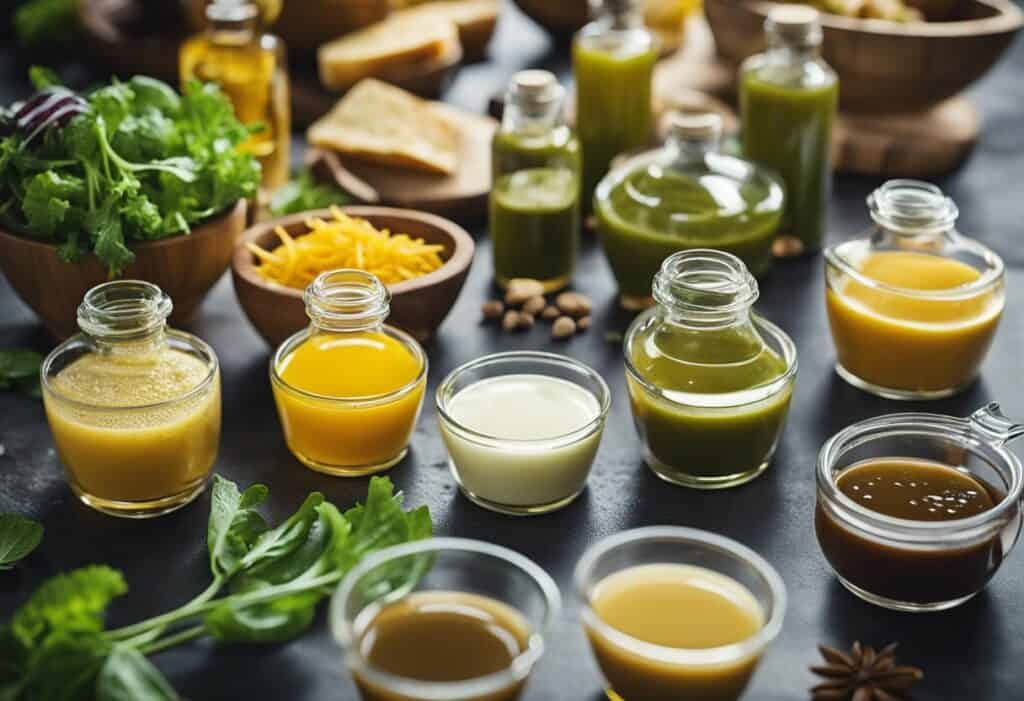
What is the composition of salad dressing?
Salad dressing is typically composed of a mixture of oil, vinegar or citrus juice, and seasonings. The specific ingredients and ratios used can vary depending on the type of salad dressing being made.
Is salad dressing a homogeneous or heterogeneous mixture?
Salad dressing is generally considered a heterogeneous mixture because it consists of multiple components that are not evenly distributed throughout the mixture. For example, oil and vinegar may separate in a vinaigrette dressing.
What are the different types of salad dressings?
There are many different types of salad dressings, including vinaigrettes, creamy dressings, and sweet dressings. Some popular varieties include ranch, Italian, Caesar, and honey mustard.
What are the main ingredients in salad dressing?
The main ingredients in salad dressing are typically oil and vinegar or citrus juice. Other common ingredients include herbs, spices, mustard, honey, and mayonnaise.
How is salad dressing made?
Salad dressing is typically made by whisking together oil, vinegar or citrus juice, and seasonings until they are well combined. Creamy dressings may also include mayonnaise or sour cream.
What are some common uses for salad dressing?
Salad dressing is primarily used to add flavor and moisture to salads, but it can also be used as a marinade for meats or vegetables. Some people also use salad dressing as a dip for raw vegetables or as a topping for sandwiches.







